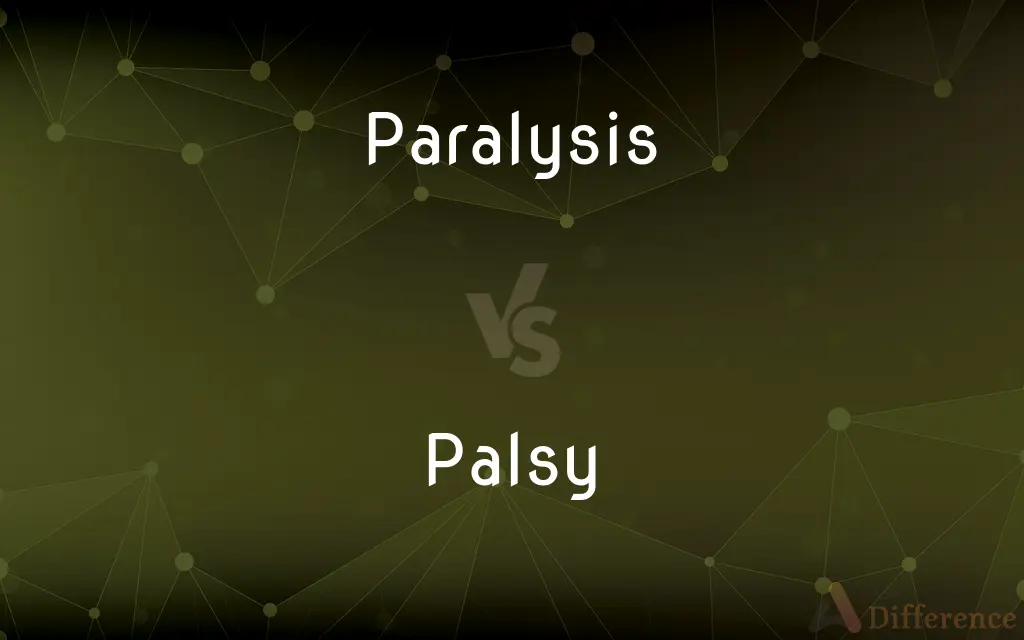Paralysis vs. Palsy — What's the Difference?
Edited by Tayyaba Rehman — By Fiza Rafique — Updated on May 3, 2024
Paralysis involves the loss of muscle function in part of the body, typically caused by damage to the nervous system, while palsy refers specifically to various disorders that result in involuntary tremors.

Difference Between Paralysis and Palsy
Table of Contents
ADVERTISEMENT
Key Differences
Paralysis is often the result of damage to the spinal cord or nerves, leading to a loss of muscle function and sensation in affected areas. Whereas palsy, such as Bell's palsy or cerebral palsy, often manifests as involuntary movements or tremors, impacting muscle control but not necessarily resulting in complete muscle paralysis.
In paralysis, the primary issue is the inability to initiate muscle movements. On the other hand, palsy might allow for movement but these movements can be uncontrolled or weakened.
Paralysis can occur in any part of the body depending on where the nervous system is damaged. Whereas palsy often has specific types that affect particular parts of the body, like facial muscles in Bell's palsy or limbs in cerebral palsy.
The causes of paralysis can vary widely from trauma, stroke, or diseases like polio. Whereas palsy is frequently associated with conditions like brain damage at birth or a viral infection affecting nerve function.
Treatment for paralysis focuses on rehabilitation and adapting to loss of muscle function. On the other hand, treatment for palsy may involve medications, physical therapy, and sometimes surgery to improve function or reduce tremors.
ADVERTISEMENT
Comparison Chart
Definition
Loss of muscle function in body parts
Disorders causing involuntary tremors
Common Causes
Trauma, stroke, nerve damage
Brain damage, viral infections
Symptoms
Inability to move affected muscles
Involuntary movements, muscle weakness
Affected Areas
Any part of the body
Often specific areas like face or limbs
Treatment Focus
Rehabilitation, adaptation
Medication, therapy, surgery
Compare with Definitions
Paralysis
Paralysis affecting the lower half of the body.
Paraplegia has confined him to a wheelchair.
Palsy
Present at birth due to brain damage.
Congenital palsy has affected his motor skills since he was an infant.
Paralysis
Characterized by weak, floppy muscles without tone.
Flaccid paralysis caused his arm to hang limply at his side.
Palsy
Sudden weakness in the muscles on one half of the face.
She woke up with Bell's palsy and couldn't smile properly.
Paralysis
Loss of all muscle function in the affected area.
She experienced complete paralysis in her legs after the accident.
Palsy
A group of disorders affecting balance and posture.
Cerebral palsy affects his ability to walk smoothly.
Paralysis
Spastic paralysis: Involves stiff and hard-to-move muscles.
Spastic paralysis makes her movements jerky and uncoordinated.
Palsy
Characterized by tremors and slow movement.
His Parkinsonian palsy manifests in a noticeable tremor.
Paralysis
Some muscle function remains in the affected area.
He has partial paralysis and can still move his fingers slightly.
Palsy
Involves the peripheral nerves and can lead to facial paralysis.
Peripheral palsy has caused asymmetry in her face.
Paralysis
Paralysis (also known as plegia) is a loss of motor function in one or more muscles. Paralysis can be accompanied by a loss of feeling (sensory loss) in the affected area if there is sensory damage as well as motor.
Palsy
Palsy is a medical term which refers to various types of paralysis, often accompanied by weakness and the loss of feeling and uncontrolled body movements such as shaking. The word originates from the Anglo-Norman paralisie, parleisie et al., from the accusative form of Latin paralysis, from Ancient Greek παράλυσις (parálusis), from παραλύειν (paralúein, “to disable on one side”), from παρά (pará, “beside”) + λύειν (lúein, “loosen”).
Paralysis
Loss or impairment of the ability to move a body part, usually as a result of damage to its nerve supply.
Palsy
Complete or partial muscle paralysis, often accompanied by loss of sensation and uncontrollable body movements or tremors.
Paralysis
Loss of sensation over a region of the body.
Palsy
A weakening or debilitating influence.
Paralysis
Inability to move or function; total stoppage or severe impairment of activity
Fear that led to national paralysis.
Palsy
An enfeebled condition or debilitated state thought to result from such an influence.
Paralysis
(pathology) The complete loss of voluntary control of part of a person's body, such as one or more limbs.
Palsy
A fit of strong emotion marked by the inability to act
"Flaherty dithered in a little palsy of indignation" (Anthony Burgess).
Paralysis
A state of being unable to act.
The government has been in a paralysis since it lost its majority in the parliament.
Palsy
To paralyze.
Paralysis
Abolition of function, whether complete or partial; esp., the loss of the power of voluntary motion, with or without that of sensation, in any part of the body; palsy. See Hemiplegia, and Paraplegia. Also used figuratively; as, paralysis of the will.
Mischievous practices arising out of the paralysis of the powers of ownership.
Palsy
To deprive of strength.
Paralysis
Loss of the ability to move a body part
Palsy
To make helpless, as with fear.
Palsy
(pathology) Complete or partial muscle paralysis of a body part, often accompanied by a loss of feeling and uncontrolled body movements such as shaking.
Palsy
To paralyse, either completely or partially.
Palsy
(colloquial) Chummy, friendly.
Palsy
Paralysis, complete or partial. See Paralysis.
Palsy
To affect with palsy, or as with palsy; to deprive of action or energy; to paralyze.
Palsy
Loss of the ability to move a body part
Palsy
A condition marked by uncontrollable tremor
Palsy
Affect with palsy
Common Curiosities
Can paralysis be treated?
While some forms of paralysis are irreversible, many cases can be managed with physical therapy and technological aids.
What are common types of palsy?
Common types include Bell's palsy, cerebral palsy, and Parkinsonian palsy.
What causes Bell's palsy?
Bell's palsy is commonly caused by inflammation or viral infections that affect facial nerves.
How does cerebral palsy affect the body?
It primarily affects body movement and muscle coordination.
Are there preventive measures for palsy?
Preventive measures depend on the type, but maintaining overall health can help reduce risks.
What is paralysis?
Paralysis is the loss of the ability to move one or more muscles, often resulting from damage to the nervous system.
What is the main difference between paralysis and palsy?
Paralysis is a complete or partial loss of muscle function, whereas palsy usually involves tremors or involuntary movements.
What is the prognosis for someone with Parkinsonian palsy?
The progression can be slow, and symptoms can be managed with medication and lifestyle adjustments.
Can exercise help with cerebral palsy?
Yes, tailored exercise programs can improve strength and coordination.
Is paralysis always permanent?
Not always; some cases, especially those caused by temporary conditions, can see partial or full recovery.
What support is available for individuals with paralysis?
Support ranges from medical treatment to adaptive devices and community resources.
Can children outgrow cerebral palsy?
Cerebral palsy is a permanent condition, but therapy can improve function and mobility.
How does peripheral palsy differ from Bell's palsy?
Peripheral palsy can affect any peripheral nerve, not just facial nerves like Bell's palsy.
What therapies are effective for paralysis?
Physical therapy, occupational therapy, and sometimes surgery are employed to manage symptoms.
How is Bell's palsy diagnosed?
Diagnosis typically involves neurological examinations and sometimes imaging tests to rule out other causes.
Share Your Discovery

Previous Comparison
Creche vs. Daycare
Next Comparison
Congruent vs. IncongruentAuthor Spotlight
Written by
Fiza RafiqueFiza Rafique is a skilled content writer at AskDifference.com, where she meticulously refines and enhances written pieces. Drawing from her vast editorial expertise, Fiza ensures clarity, accuracy, and precision in every article. Passionate about language, she continually seeks to elevate the quality of content for readers worldwide.
Edited by
Tayyaba RehmanTayyaba Rehman is a distinguished writer, currently serving as a primary contributor to askdifference.com. As a researcher in semantics and etymology, Tayyaba's passion for the complexity of languages and their distinctions has found a perfect home on the platform. Tayyaba delves into the intricacies of language, distinguishing between commonly confused words and phrases, thereby providing clarity for readers worldwide.
















































